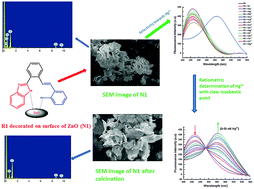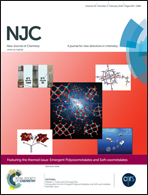ZnO decorated with organic nanoparticles based sensor for the ratiometric selective determination of mercury ions†
Abstract
ZnO nanoparticles decorated with organic receptor 1 (R1) have been prepared and the resultant compound (N1) was investigated for its metal recognition ability. N1 was found to be selective for mercury ions (Hg2+) in a DMSO/water mixture in a ratio of 7 : 3 and possessed no interference from any of the potential interferent metal ions. The crystal size and morphology of ZnO is characterized using various spectroscopic and diffraction techniques like scanning electron microscopy, X-ray diffraction (XRD), dynamic light scattering (DLS), etc. Surface decoration of the ZnO with receptor 1 is confirmed using NMR spectroscopy. On successive additions of Hg2+ ions, the fluoresence intensity of the compound was quenched at 427 nm with enhancement of the peak at 482 nm, which led to ratiometric sensor development for the recognition of mercury ions having a detection limit of 0.19 nM. The prepared receptor was also tested for real sample application by preparing a known concentration of Hg2+ solution and it was found to respond well with an accuracy more than 90%.


 Please wait while we load your content...
Please wait while we load your content...